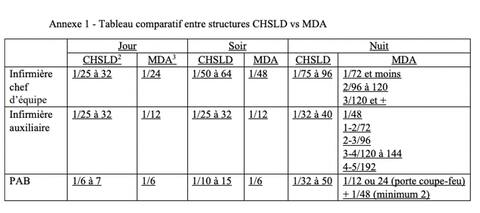There will be up to twice as many employees in Quebec’s seniors’ homes as in dilapidated CHSLDs, the government’s ratios predict, even if the two services are public and are aimed at the same vulnerable clientele.
The newspaper obtained the recommendation grid from the National Directorate of Nursing Care and Services, dated December 2021, which suggests more advantageous ratios for seniors’ homes (MDA) than in residential and long-term care centers ( CHSLD).
The difference is striking for nursing assistants: they will be responsible for a maximum of 12 day or evening residents in an MDA. In CHSLDs, the ratio climbs to 32 residents (see table).
Courtesy
Comparative table of employee ratios for residents in CHSLDs and MDAs (seniors’ homes), compiled by the community of practice on care for the elderly in residential centers affiliated with Laval University. COURTESY
In addition, a night nurse in an MDA must have 72 residents or less in her care. In a CHSLD? This figure climbs to 96, and sometimes even exceeds this standard.
- Listen to Jérome Rousseau, vice president of the Fédération interprofessionnelle de la santé du Québec (FIQ) at the microphone of Philippe-Vincent Foisy via QUB-radio :
Two classes of accommodation
“I am flabbergasted, protests Paul Brunet, president of the Council for the protection of the sick. It is a two-tier system. […] It means that there are like two classes of people accommodated.
Due to a “organization of care adapted to the habits of residents, including the administration of medication on a personalized schedule, the number of evening practical nurses is higher than in regular CHSLDs”, indicates the ministerial document.
Consulted by the government for the MDA project, the Community of practice on care for the elderly in residential centers (affiliated with Laval University), denounces this inequity.
“In addition to benefiting from an environment better suited to their condition, MDA residents will also be supported by a greater number of caregivers,” reads a university document published last Tuesday.
However, the clientele is “almost identical”, we read. According to Philippe Voyer, group manager, this gap makes many people “uncomfortable”.
“We have known for a long time. We were waiting for MDAs to open to see if it would materialize, he says. I am not able to defend these choices.
To date, only four MDAs have opened their doors (Sherbrooke, Thetford Mines, Lévis, Rivière-du-Loup). At the Estrie Integrated University Health and Social Services Center, management confirms that it applies separate ratios.
Like a lottery
“There are really better ratios, also notes Stéphanie Goulet, interim president of the union of nurses of Estrie (FIQ), about the MDA. Who is going to win the lottery to go to those places? It is completely unfair to the population.”
At the MDA in Rivière-du-Loup, the night nurse takes care of 60 patients. At the CHSLD in Rimouski, it is almost double (112), show documents obtained through access to information.
According to the Community of Practice, the ratios in CHSLDs should be increased as in MDAs, which are better suited. In addition, CHSLDs are less well equipped in terms of technologies, air conditioning and adapted spaces.
“Our CHSLDs will empty out to go to the MDAs, we will play musical chairs, believes Julie Daigneault, president of the Laurentian nurses’ union (FIQ). It takes better ratios everywhere in Quebec.”
Last February, the Minister of Seniors, Sonia Bélanger, confirmed that the mechanisms for accessing CHSLDs and MDAs are the same.
Outdated and dangerous ratios
Nurses are responsible for more than 100 patients at night in certain public CHSLDs, a completely exceeded and dangerous ratio, deplore employees.
“It is unacceptable, it must change as soon as possible, insists Julie Daigneault, president of the local union of nurses in the Laurentians (FIQ). It is dangerous, it is not true that patients sleep at night!”
MARTIN ALARIE / MONTREAL JOURNAL
Julie Daigneault, president of the union of nurses of the Laurentians (FIQ) in front of the CHSLD of the Heights, in Sainte-Adèle, where the night nurse takes care of 106 residents.
The ratios in place in long-term care residential centers (CHSLDs) provide that a night nurse must not have more than 96 residents in her charge.
Over 100 residents
However, in several residences in the Laurentians, some take care of more than 100 users, show data obtained via the Access to Information Act. At the CHSLD in Rimouski, the night nurse even has 112 residents in her care.
Often, employees walk on several floors and have to intervene for all kinds of emergencies (falls, pain, discomfort).
“It’s a hellish turnover with incredible stress,” admits Mme Daigneault.
It’s been nearly 20 years (2004) that Philippe Voyer, professor of nursing at Laval University, has developed safe ratios for CHSLDs. For several years, the integrated health and social services centers (CISSS) have been striving to respect them.
But these scales are no longer safe to respond to customers.
“It’s no longer adequate at all,” admits Mr. Voyer himself. With the heaviness of the clientele, the scale is no longer up to date.
On the North Shore, some residences do not even have nurses on site at night. The nursing assistant, who cannot assess a patient who has fallen, must therefore call for reinforcements if necessary.
A nurse at all times?
“In the ideal world, there should be a nurse on each shift at least,” admits Karine Ouellet Moreau, president of the local union of nurses (CSQ) on the North Shore.
According to Mr. Voyer, the ratios should be more adapted to the clientele and adjusted as needs evolve.
“Static ratios are outdated as a mode of operation,” believes the specialist.




